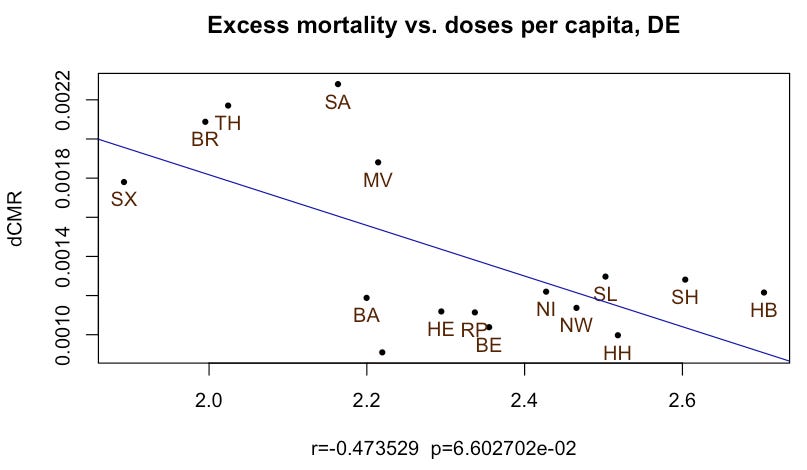A common argument used by vaccination advocates is the claim that excess mortality was particularly high in German federal states with low vaccination rates. In this article, I use a simple statistical method to show what pathetic nonsense this is.
Related articles on social networks are usually pumped up with pseudo scientific painture work that is intended to suggest proof (example Fig. 1).
Fig. 1: Typical diagram of a correlation of vaccination rate and excess mortality in German federal states. Source: X (Twitter) Link.
To check it out, I collected the necessary data on the living and dead from Destatis and the vaccinated from the RKI (Robert Koch Institute), calculated the difference in the crude mortality rate in 2021 and 2022 compared to 2019 (dCMR) and also the doses per capita. All of this separately for the 16 federal states. The result confirms a Spearman correlation r = -0.47 ( p = 0.07 ). This is mistakenly understood to mean that excess mortality appears to be less severe in areas with higher vaccination rates (Fig. 2).
Fig. 2: Excess mortality 2021/22 in comparison to 2019 and vaccinations, 16 federal states of Germany.
However, it is striking that this correlation is mainly based on 5 data points in the top-left quarter of the diagram. They represent the eastern federal states that joined the Federal Republic of Germany in 1990. It is well known that several epidemiological conditions there are different from those in the West. I picked out the mean age of the population because the older population groups are usually heavily involved during times of excess mortality. So take a look at Fig. 3. The Spearman correlation is r = 0.90 with extraordinary significance. Oops.
Fig. 3: Excess Mortality depending on mean age in 16 federal states.
What we see here is a classic confounder, an influencing variable that affects the target variable of excess mortality, and here does so with great force.
We are now entering an area of statistics that allows the investigation of so-called partial correlation. This involves determining the relationship between variables x and y under the assumption that z also plays a role. I fed R (package ppcore) with the figures and obtained the following result. The correlation r = -0.47 ( p = 0.07 ) then collapses to the partial correlation r = 0.12 ( p = 0.67 ). The actual connection of the vaccination rate and the excess mortality, taking into account the mean age, is reversed and anything but significant. Oops oops.
To be on the safe side, I repeated the calculation and assumed that the average age and excess mortality were related and that the vaccination rate was now the confounder. This leads to a Spearman correlation r = 0.87 ( p = 2.8e-5 ), i.e. still a strong and highly significant connection.
The bottom line is not that average age is the one an only explanation for excess mortality, even if it seems like it is the main cause. The bottom line is, the influence of vaccination rates on excess mortality has been debunked as a spurious correlation and therefore has to be rated as nonsense.
Addendum
cm27874 made a funny suggestion in the comments about how to prove the nonsense using an impossible connection. So I connected the difference in mortality from 2020 compared to 2019 with the vaccination rates and got a negative, significant Spearman correlation r = -0.53 ( p = 0.04 ). Accordingly, treatments that began in 2021 would have influenced mortality in 2020, which is impossible.
Fig. 4: Excess mortality 2020 in comparison to 2019 and vaccinations, 16 federal states of Germany.








Thank you Ulf! You have demonstrated a point that I have long raised in conversation: I concede that vaccination "might" correlate with lower mortality rates, BUT the strongest correlation remains age/health profile. This is the essence of HUB - "Healthy User Bias" which undermines so many of pharma's claims.
Einen ähnlichen Befund, Haupteinflußgröße Durchschnittsalter, ergab meine Analyse mittels Zwei-Parameter-Fit: https://corona-blog.net/2022/08/27/gesamtsterbefallzahl-korreliert-jetzt-noch-signifikanter-positiv-mit-impfquote-beim-vergleich-aller-deutscher-bundeslaender/
Aber zusätzlich zeigt sich eine starke positive Korrelation zwischen „Impf“-quote und Sterbewahrscheinlichkeit, also hohe Sterbewahrscheinlichkeit bei hoher „Impf“-quote